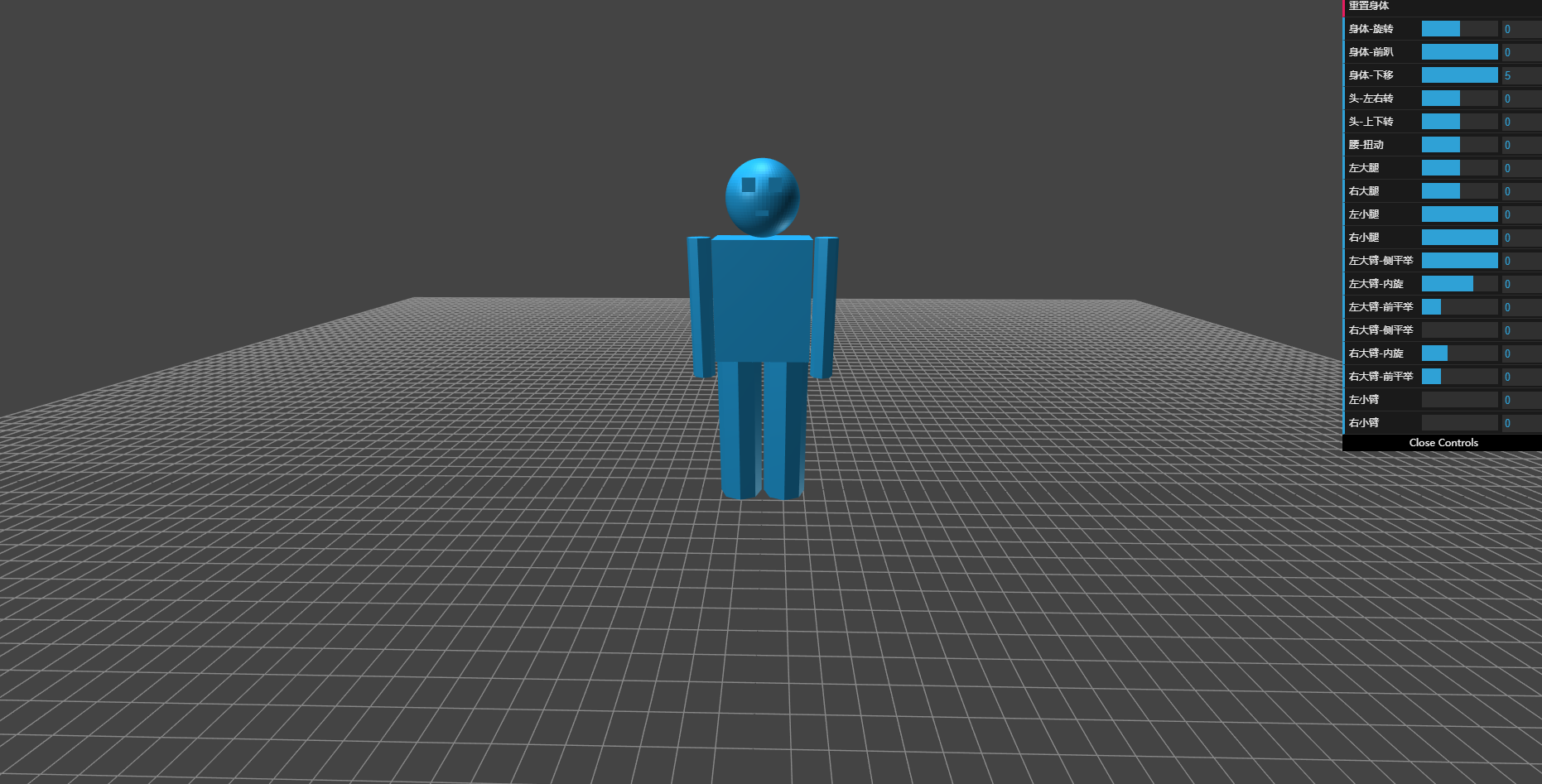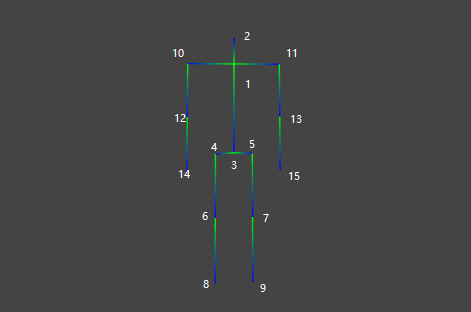上一篇郭先生解析了一下官方的骨骼动画案例,这篇郭先生就要做一个稍微复杂一点的骨骼动画了,就拿一个小人下手吧。在线案例请点击博客原文。话不多说先上大图

骨骼动画在GUI上面都有体现。制作骨骼动画的步骤在官方案例中已经看到了,这里在回忆一下。骨骼动画的基本步骤
- 创建一个BufferGeometry,并添加skinIndex和skinWeight两个属性。
- 创建骨骼Bone
- 建蒙皮材质Material
- 根据BufferGeometry和Material创建蒙皮网格SkinnedMesh
- 根据Bone创建骨架Skeleton
- SkinnedMesh添加骨骼根节点
- innedMesh绑定骨架
总结起来差不多就这7步,接下来我们一步一步从零创建一个这样的小人
1. 创建一个BufferGeometry,并添加skinIndex和skinWeight两个属性。
我们有几种方案创建这样的复杂几何体。
- 使用threeBSP创建这样的几何体,优点是二元操作更加的强大,能做出复杂几何体,缺点是性能开销大。
- 使用BufferGeometry的merge方法,将几何体合并,优点是性能好,缺点是只能将几何体合并。
- 直接引用模型
我们采用第二种方法。
let head = new THREE.SphereGeometry(3, 60, 40); let eye_l = new THREE.BoxGeometry(2, 1, 1); let eye_r = new THREE.BoxGeometry(2, 1, 1); let mouth = new THREE.BoxGeometry(2, 0.4, 1); head.merge(eye_l, new THREE.Matrix4().makeTranslation(2, 1, 1)) head.merge(eye_r, new THREE.Matrix4().makeTranslation(2, 1, -1)) head.merge(mouth, new THREE.Matrix4().makeTranslation(2, -1, 0)) let body = new THREE.BoxGeometry(5, 10, 8, 1, 20, 1); let leg_l = new THREE.CylinderGeometry(2, 2, 14, 8, 14); let leg_r = new THREE.CylinderGeometry(2, 2, 14, 8, 14); let arm_l = new THREE.CylinderGeometry(1, 1, 12, 8, 11); let arm_r = new THREE.CylinderGeometry(1, 1, 12, 8, 11); let human = body.clone(); human.merge(head, new THREE.Matrix4().makeTranslation(0, 8, 0)); human.merge(leg_l, new THREE.Matrix4().makeTranslation(0, -12, 2.1)); human.merge(leg_r, new THREE.Matrix4().makeTranslation(0, -12, -2.1)); human.merge(arm_l, new THREE.Matrix4().makeTranslation(0, -1, 5.3)); human.merge(arm_r, new THREE.Matrix4().makeTranslation(0, -1, -5.3)); human = new THREE.BufferGeometry().fromGeometry(human);
这里创建小人几何体完毕。接下来是并添加skinIndex和skinWeight两个属性。
var skinIndices = []; var skinWeights = []; let position = human.attributes.position; var vertex = new THREE.Vector3(); for(let i=0; i<position.count; i++) { vertex.fromBufferAttribute(position, i); if(vertex.z > 4.3 && vertex.y >= 0) { skinIndices.push(9,0,0,0); skinWeights.push(1,0,0,0); } else if (vertex.z < -4.3 && vertex.y >= 0) { skinIndices.push(10,0,0,0); skinWeights.push(1,0,0,0); } else if (vertex.z > 4.3 && vertex.y < 0) { skinIndices.push(11,0,0,0); skinWeights.push(1,0,0,0); } else if (vertex.z < -4.3 && vertex.y < 0) { skinIndices.push(12,0,0,0); skinWeights.push(1,0,0,0); } else if (vertex.y <= 5 && vertex.y >= -5) { let w = (vertex.y + 5) / 10; skinIndices.push(0,2,0,0); skinWeights.push(Math.sqrt(w),1-Math.sqrt(w),0,0); } else if (vertex.y > 5) { skinIndices.push(1,0,0,0); skinWeights.push(1,0,0,0); } else if(vertex.y < -5 && vertex.y >= -12 && vertex.z > 0) { skinIndices.push(3,0,0,0); skinWeights.push(1,0,0,0); } else if (vertex.y < -12 && vertex.z > 0) { skinIndices.push(5,0,0,0); skinWeights.push(1,0,0,0); } else if (vertex.y < -5 && vertex.y >= -12 && vertex.z < 0) { skinIndices.push(4,0,0,0); skinWeights.push(1,0,0,0); } else { skinIndices.push(6,0,0,0); skinWeights.push(1,0,0,0); } } human.setAttribute('skinIndex', new THREE.Uint16BufferAttribute(skinIndices, 4)); human.setAttribute('skinWeight', new THREE.Float32BufferAttribute(skinWeights, 4));
这里根据几何体顶点的x,y,z值来添加索引和权重,
2. 创建骨骼Bone
骨骼的节点如下图

其中bone1为根节点。
let bones = []; let bone1 = new THREE.Bone(); //胸 bone1.position.y = 5; let bone2 = new THREE.Bone(); //头 bone2.position.y = 3; let bone3 = new THREE.Bone(); //尾椎 bone3.position.y = -10; let bone4 = new THREE.Bone(); //左腿上 bone4.position.y = -0.1; bone4.position.z = 2.1; let bone5 = new THREE.Bone(); //右腿上 bone5.position.y = -0.1; bone5.position.z = -2.1; let bone6 = new THREE.Bone(); //左腿中 bone6.position.y = -7; let bone7 = new THREE.Bone(); //右腿中 bone7.position.y = -7; let bone8 = new THREE.Bone(); //左腿下 bone8.position.y = -7; let bone9 = new THREE.Bone(); //右腿下 bone9.position.y = -7; let bone10 = new THREE.Bone(); //左臂上 bone10.position.z = 5.3; let bone11 = new THREE.Bone(); //右臂上 bone11.position.z = -5.3; let bone12 = new THREE.Bone(); //左臂中 bone12.position.y = -6; let bone13 = new THREE.Bone(); //右臂中 bone13.position.y = -6; let bone14 = new THREE.Bone(); //左臂下 bone14.position.y = -6; let bone15 = new THREE.Bone(); //右臂下 bone15.position.y = -6; bone1.add(bone2); bone1.add(bone3); bone1.add(bone10) bone1.add(bone11) bone3.add(bone4); bone3.add(bone5); bone4.add(bone6); bone5.add(bone7); bone6.add(bone8); bone7.add(bone9); bone10.add(bone12) bone11.add(bone13) bone12.add(bone14) bone13.add(bone15) bones.push(bone1); bones.push(bone2); bones.push(bone3); bones.push(bone4); bones.push(bone5); bones.push(bone6); bones.push(bone7); bones.push(bone8); bones.push(bone9); bones.push(bone10); bones.push(bone11); bones.push(bone12); bones.push(bone13); bones.push(bone14); bones.push(bone15);
3. 创建蒙皮材质Material
这个比较简单,就是打开材质的蒙皮属性skinning: true。
let material = new THREE.MeshPhongMaterial({ skinning: true, color: 0x156289, emissive: 0x072534, side: THREE.DoubleSide, flatShading: true, // wireframe: true, })
4. 根据BufferGeometry和Material创建蒙皮网格SkinnedMesh
mesh = new THREE.SkinnedMesh(human, material);
5. 根据Bone创建骨架Skeleton
let skeleton = new THREE.Skeleton(bones);
6. SkinnedMesh添加骨骼根节点
mesh.add(bones[0]);
7. SkinnedMesh绑定骨架
mesh.bind(skeleton);
8. 添加界面交互GUI
var bones = mesh.skeleton.bones; gui.add( mesh, "pose" ); gui.add(bones[0].rotation, 'y', bones[0].rotation.y - Math.PI/4, bones[0].rotation.y + Math.PI/4); gui.add(bones[0].rotation, 'z', bones[0].rotation.z - Math.PI/2, bones[0].rotation.z); gui.add(bones[0].position, 'y', bones[0].position.y - 21.5, bones[0].position.y); gui.add(bones[1].rotation, 'y', bones[1].rotation.y - Math.PI/4, bones[1].rotation.y + Math.PI/4); gui.add(bones[1].rotation, 'z', bones[1].rotation.z - Math.PI/6, bones[1].rotation.z + Math.PI/6); gui.add(bones[2].rotation, 'y', bones[2].rotation.y - Math.PI/6, bones[2].rotation.y + Math.PI/6); gui.add(bones[3].rotation, 'z', bones[3].rotation.z - Math.PI/3, bones[3].rotation.z + Math.PI/3); gui.add(bones[4].rotation, 'z', bones[4].rotation.z - Math.PI/3, bones[4].rotation.z + Math.PI/3); gui.add(bones[5].rotation, 'z', bones[5].rotation.z - Math.PI/3, bones[5].rotation.z); gui.add(bones[6].rotation, 'z', bones[6].rotation.z - Math.PI/3, bones[6].rotation.z); gui.add(bones[9].rotation, 'x', bones[9].rotation.x - Math.PI, bones[9].rotation.x); gui.add(bones[9].rotation, 'y', bones[9].rotation.y - Math.PI/2, bones[9].rotation.y + Math.PI/4); gui.add(bones[9].rotation, 'z', bones[9].rotation.z - Math.PI/3, bones[9].rotation.z + Math.PI); gui.add(bones[10].rotation, 'x', bones[10].rotation.x, bones[10].rotation.x + Math.PI); gui.add(bones[10].rotation, 'y', bones[10].rotation.y - Math.PI/4, bones[10].rotation.y + Math.PI/2); gui.add(bones[10].rotation, 'z', bones[10].rotation.z - Math.PI/3, bones[10].rotation.z + Math.PI); gui.add(bones[11].rotation, 'z', bones[11].rotation.z, bones[11].rotation.z + Math.PI/4*3); gui.add(bones[12].rotation, 'z', bones[12].rotation.z, bones[12].rotation.z + Math.PI/4*3); gui.__controllers[0].name("重置身体"); gui.__controllers[1].name("身体-旋转"); gui.__controllers[2].name("身体-前趴"); gui.__controllers[3].name("身体-下移"); gui.__controllers[4].name("头-左右转"); gui.__controllers[5].name("头-上下转"); gui.__controllers[6].name("腰-扭动"); gui.__controllers[7].name("左大腿"); gui.__controllers[8].name("右大腿"); gui.__controllers[9].name("左小腿"); gui.__controllers[10].name("右小腿"); gui.__controllers[11].name("左大臂-侧平举"); gui.__controllers[12].name("左大臂-内旋"); gui.__controllers[13].name("左大臂-前平举"); gui.__controllers[14].name("右大臂-侧平举"); gui.__controllers[15].name("右大臂-内旋"); gui.__controllers[16].name("右大臂-前平举"); gui.__controllers[17].name("左小臂"); gui.__controllers[18].name("右小臂");
这样就完成了一个骨骼动画的模型,是不是很简单呢。下篇我们继续完善它,添加帧动画让他动起来。
转载请注明地址:郭先生的博客